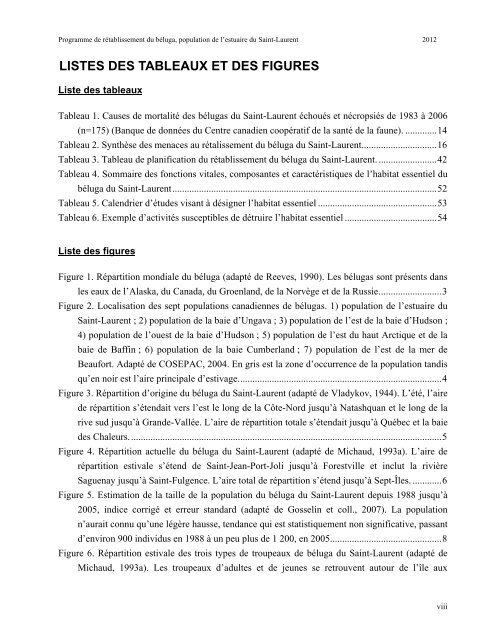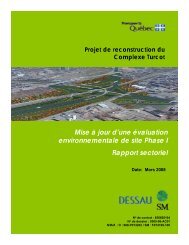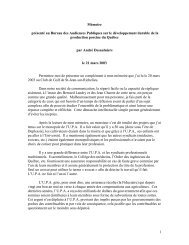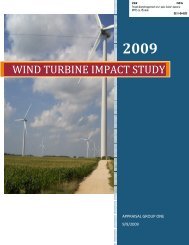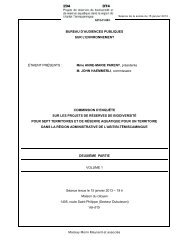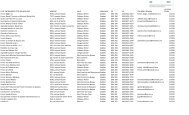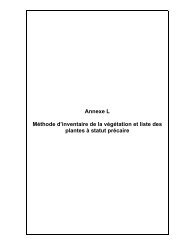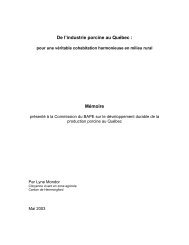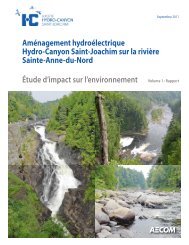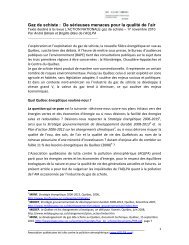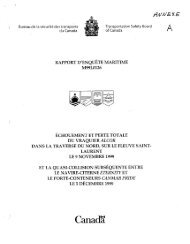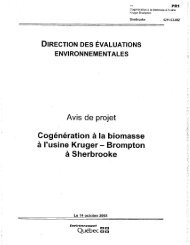Programme de rétablissement du béluga - BAPE - Gouvernement ...
Programme de rétablissement du béluga - BAPE - Gouvernement ...
Programme de rétablissement du béluga - BAPE - Gouvernement ...
You also want an ePaper? Increase the reach of your titles
YUMPU automatically turns print PDFs into web optimized ePapers that Google loves.
<strong>Programme</strong> <strong>de</strong> <strong>rétablissement</strong> <strong>du</strong> <strong>béluga</strong>, population <strong>de</strong> l’estuaire <strong>du</strong> Saint-Laurent 2012<br />
LISTES DES TABLEAUX ET DES FIGURES<br />
Liste <strong>de</strong>s tableaux<br />
Tableau 1. Causes <strong>de</strong> mortalité <strong>de</strong>s <strong>béluga</strong>s <strong>du</strong> Saint-Laurent échoués et nécropsiés <strong>de</strong> 1983 à 2006<br />
(n=175) (Banque <strong>de</strong> données <strong>du</strong> Centre canadien coopératif <strong>de</strong> la santé <strong>de</strong> la faune). ............. 14<br />
Tableau 2. Synthèse <strong>de</strong>s menaces au rétalissement <strong>du</strong> <strong>béluga</strong> <strong>du</strong> Saint-Laurent ............................... 16<br />
Tableau 3. Tableau <strong>de</strong> planification <strong>du</strong> <strong>rétablissement</strong> <strong>du</strong> <strong>béluga</strong> <strong>du</strong> Saint-Laurent. ........................ 42<br />
Tableau 4. Sommaire <strong>de</strong>s fonctions vitales, composantes et caractéristiques <strong>de</strong> l’habitat essentiel <strong>du</strong><br />
<strong>béluga</strong> <strong>du</strong> Saint-Laurent ............................................................................................................. 52<br />
Tableau 5. Calendrier d’étu<strong>de</strong>s visant à désigner l’habitat essentiel ................................................. 53<br />
Tableau 6. Exemple d’activités susceptibles <strong>de</strong> détruire l’habitat essentiel ...................................... 54<br />
Liste <strong>de</strong>s figures<br />
Figure 1. Répartition mondiale <strong>du</strong> <strong>béluga</strong> (adapté <strong>de</strong> Reeves, 1990). Les <strong>béluga</strong>s sont présents dans<br />
les eaux <strong>de</strong> l’Alaska, <strong>du</strong> Canada, <strong>du</strong> Groenland, <strong>de</strong> la Norvège et <strong>de</strong> la Russie. ......................... 3<br />
Figure 2. Localisation <strong>de</strong>s sept populations canadiennes <strong>de</strong> <strong>béluga</strong>s. 1) population <strong>de</strong> l’estuaire <strong>du</strong><br />
Saint-Laurent ; 2) population <strong>de</strong> la baie d’Ungava ; 3) population <strong>de</strong> l’est <strong>de</strong> la baie d’Hudson ;<br />
4) population <strong>de</strong> l’ouest <strong>de</strong> la baie d’Hudson ; 5) population <strong>de</strong> l’est <strong>du</strong> haut Arctique et <strong>de</strong> la<br />
baie <strong>de</strong> Baffin ; 6) population <strong>de</strong> la baie Cumberland ; 7) population <strong>de</strong> l’est <strong>de</strong> la mer <strong>de</strong><br />
Beaufort. Adapté <strong>de</strong> COSEPAC, 2004. En gris est la zone d’occurrence <strong>de</strong> la population tandis<br />
qu’en noir est l’aire principale d’estivage. ................................................................................... 4<br />
Figure 3. Répartition d’origine <strong>du</strong> <strong>béluga</strong> <strong>du</strong> Saint-Laurent (adapté <strong>de</strong> Vladykov, 1944). L’été, l’aire<br />
<strong>de</strong> répartition s’étendait vers l’est le long <strong>de</strong> la Côte-Nord jusqu’à Natashquan et le long <strong>de</strong> la<br />
rive sud jusqu’à Gran<strong>de</strong>-Vallée. L’aire <strong>de</strong> répartition totale s’étendait jusqu’à Québec et la baie<br />
<strong>de</strong>s Chaleurs. ................................................................................................................................ 5<br />
Figure 4. Répartition actuelle <strong>du</strong> <strong>béluga</strong> <strong>du</strong> Saint-Laurent (adapté <strong>de</strong> Michaud, 1993a). L’aire <strong>de</strong><br />
répartition estivale s’étend <strong>de</strong> Saint-Jean-Port-Joli jusqu’à Forestville et inclut la rivière<br />
Saguenay jusqu’à Saint-Fulgence. L’aire total <strong>de</strong> répartition s’étend jusqu’à Sept-Îles. ............ 6<br />
Figure 5. Estimation <strong>de</strong> la taille <strong>de</strong> la population <strong>du</strong> <strong>béluga</strong> <strong>du</strong> Saint-Laurent <strong>de</strong>puis 1988 jusqu’à<br />
2005, indice corrigé et erreur standard (adapté <strong>de</strong> Gosselin et coll., 2007). La population<br />
n’aurait connu qu’une légère hausse, tendance qui est statistiquement non significative, passant<br />
d’environ 900 indivi<strong>du</strong>s en 1988 à un peu plus <strong>de</strong> 1 200, en 2005.............................................. 8<br />
Figure 6. Répartition estivale <strong>de</strong>s trois types <strong>de</strong> troupeaux <strong>de</strong> <strong>béluga</strong> <strong>du</strong> Saint-Laurent (adapté <strong>de</strong><br />
Michaud, 1993a). Les troupeaux d’a<strong>du</strong>ltes et <strong>de</strong> jeunes se retrouvent autour <strong>de</strong> l’île aux<br />
viii


